Abstract
In reviewing the properties of heterochromatin and satellite DNA in man, it is clear that the human genome does not readily lend itself to experimental tests of the postulated functions for satellite DNA. Since the spectrum of known structural properties of vertebrate and invertebrate satellite DNAs are broadly overlapping, an alternative avenue is to experimentally manipulate the heterochromatin of an organism, and then evaluate the generality of the results. When this is done in Drosophila melanogaster, the one organism where such an experimental approach is indeed possible, the results provide no support for most of the popular hypotheses concerning satellite DNA function. They do, however, reveal an important effect on the meiotic system, namely that the position of crossover events can be markedly altered in the presence of heterochromatin known to be rich in satellite DNAs. This effect is not peculiar to Drosophila, since supporting data are readily available from natural situations in both mammals and grasshoppers. In all such cases, the effects are most easily discernible where the heterochromatic blocks are substantial in size, and non-centric in location, situations which do not apply in man. The human system, however, offers other potentials. The ubiquity of naturally occurring heterochromatic polymorphisms, coupled with the extreme sensitivity of the human genome to perturbation, offers some scope for assessing the possible somatic effects of alterations in the amount of satellite DNA.
Full text
PDF




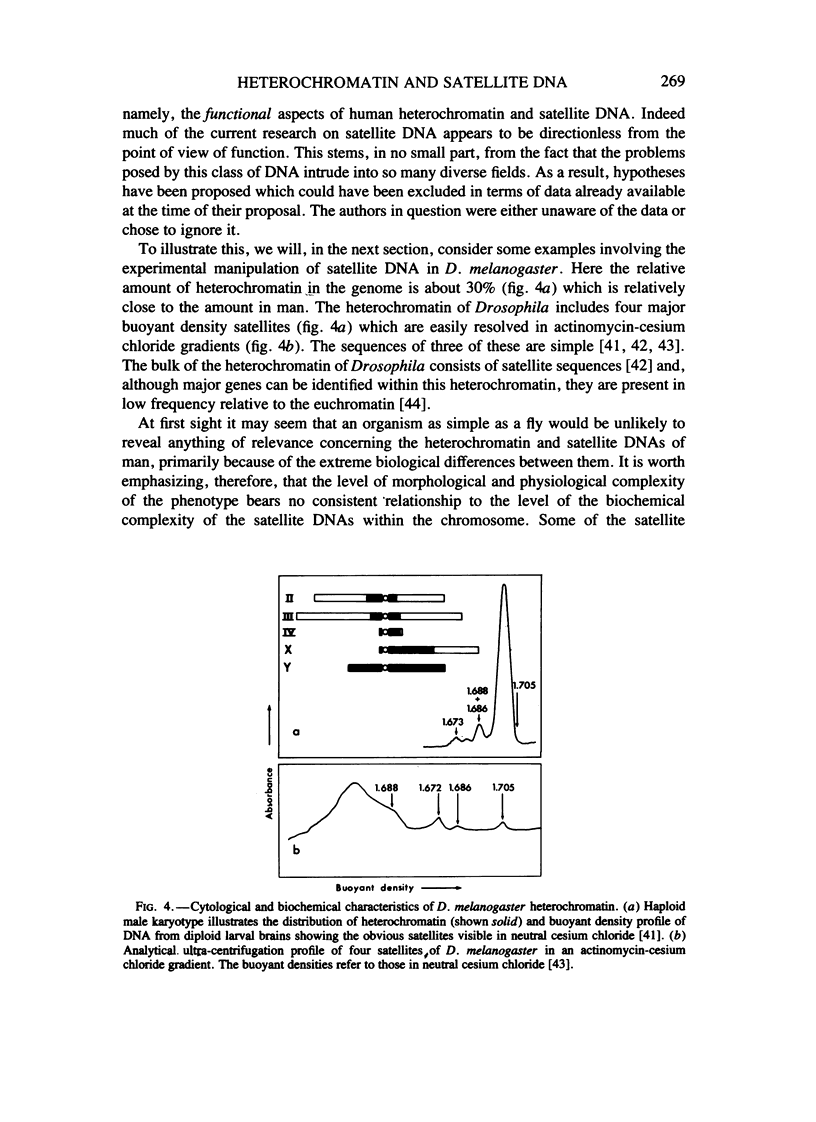

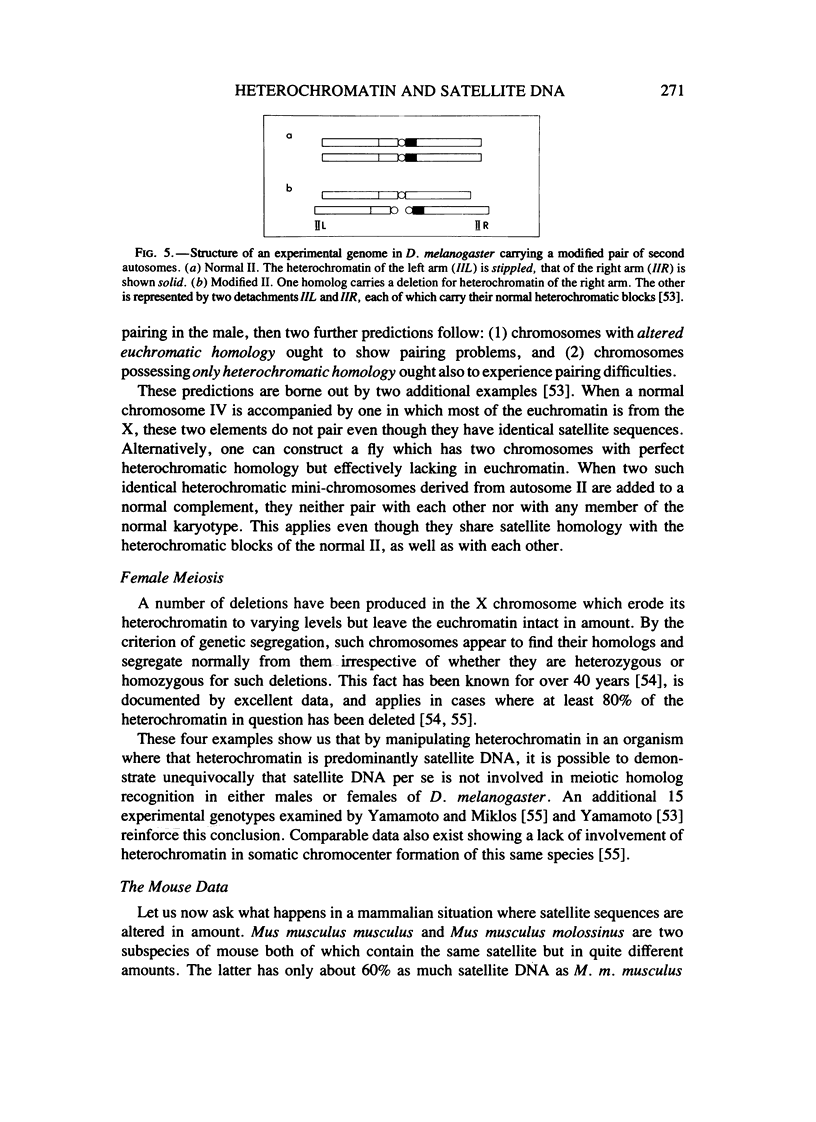
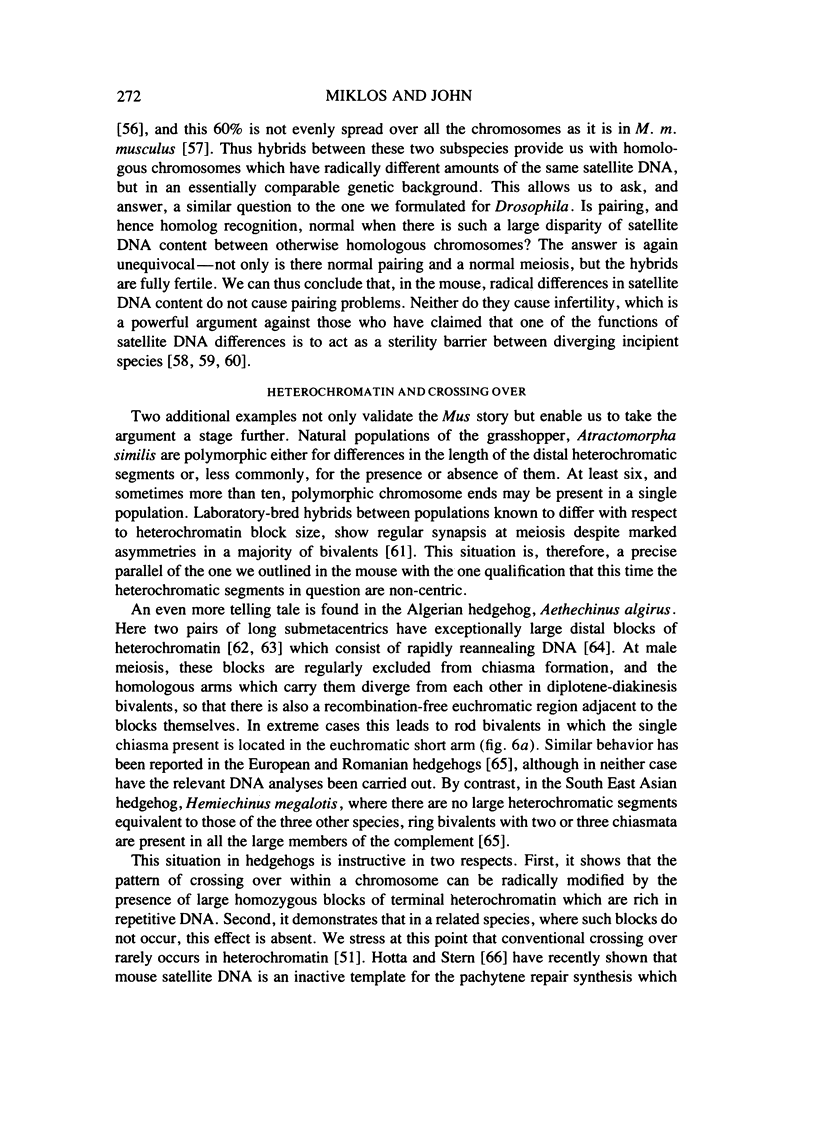
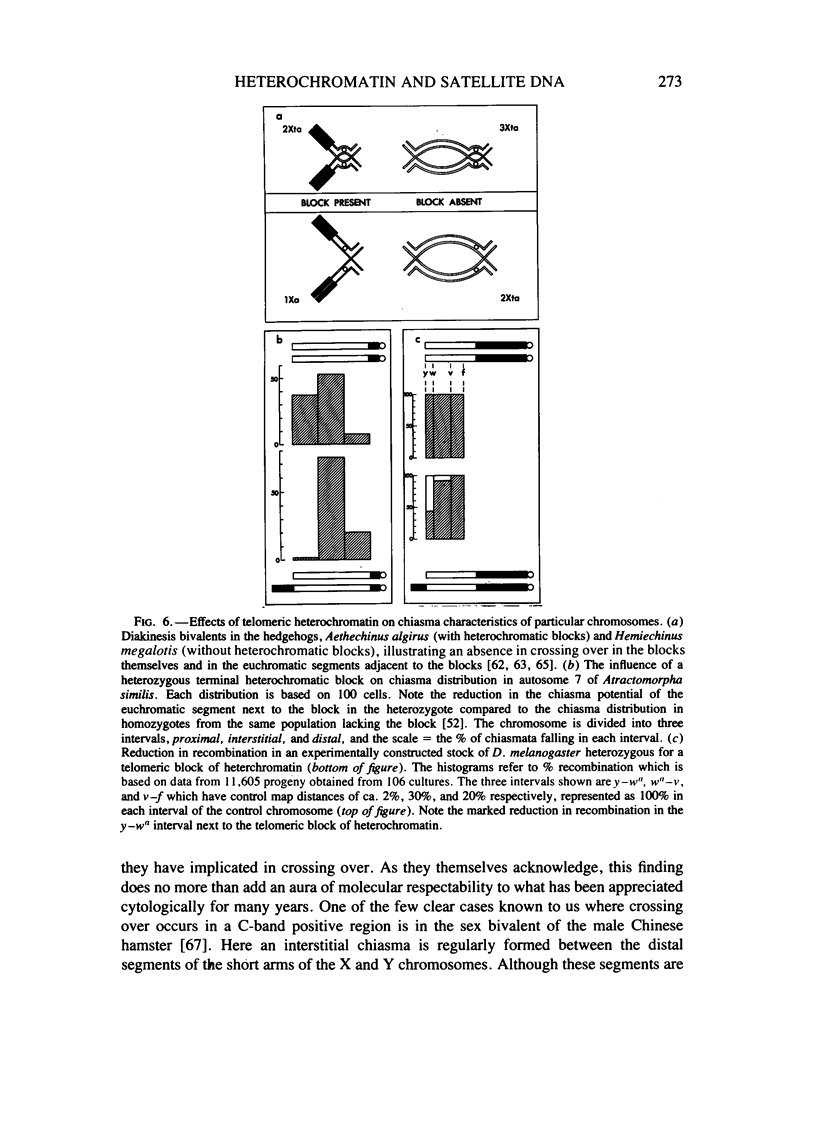





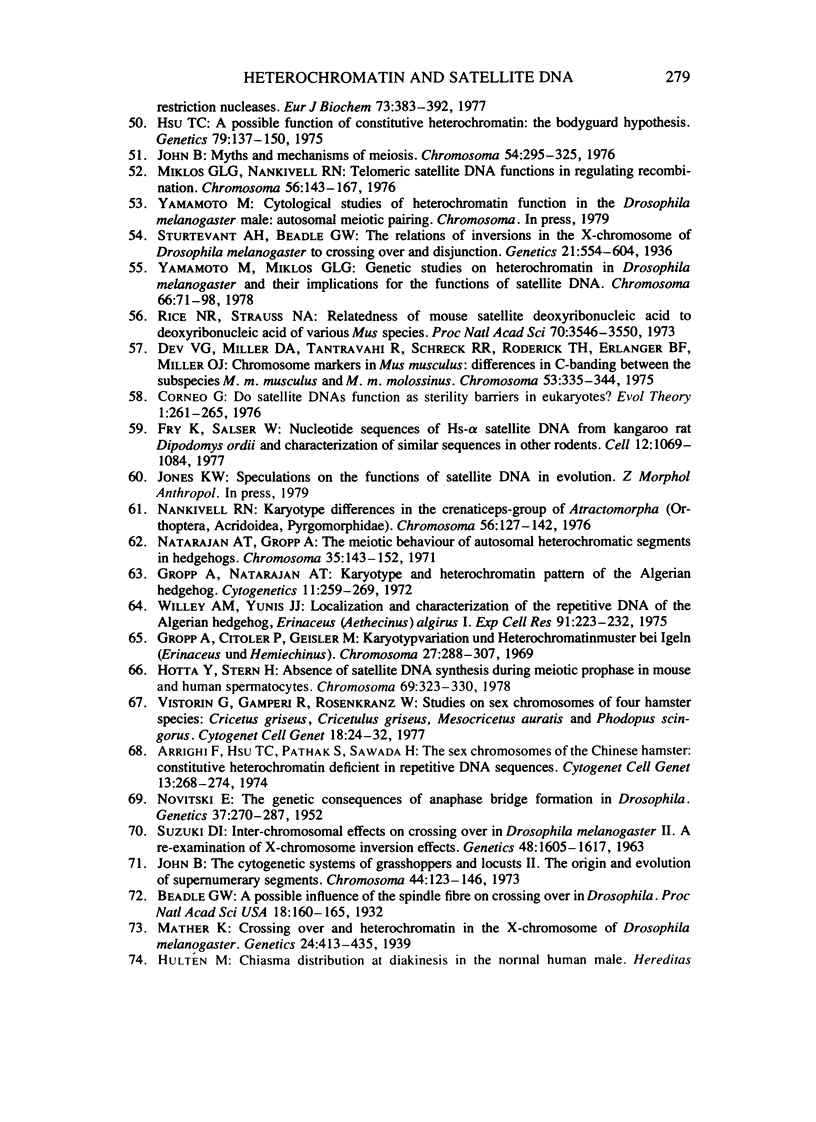

Selected References
These references are in PubMed. This may not be the complete list of references from this article.
- Arrighi F. E., Hsu T. C. Localization of heterochromatin in human chromosomes. Cytogenetics. 1971;10(2):81–86. doi: 10.1159/000130130. [DOI] [PubMed] [Google Scholar]
- Arrighi F. E., Hsu T. C., Pathak S., Sawada H. The sex chromosomes of the Chinese hamster: constitutive heterochromatin deficient in repetitive DNA sequences. Cytogenet Cell Genet. 1974;13(3):268–274. doi: 10.1159/000130278. [DOI] [PubMed] [Google Scholar]
- Beadle G. W. A Possible Influence of the Spindle Fibre on Crossing-Over in Drosophila. Proc Natl Acad Sci U S A. 1932 Feb;18(2):160–165. doi: 10.1073/pnas.18.2.160. [DOI] [PMC free article] [PubMed] [Google Scholar]
- Bostock C. J., Gosden J. R., Mitchell A. R. Localisation of a male-specific DNA fragment to a sub-region of the human Y chromosome. Nature. 1978 Mar 23;272(5651):324–328. doi: 10.1038/272324a0. [DOI] [PubMed] [Google Scholar]
- Brutlag D., Appels R., Dennis E. S., Peacock W. J. Highly repeated DNA in Drosophila melanogaster. J Mol Biol. 1977 May 5;112(1):31–47. doi: 10.1016/s0022-2836(77)80154-x. [DOI] [PubMed] [Google Scholar]
- Comings D. E. The structure and function of chromatin. Adv Hum Genet. 1972;3:237–431. doi: 10.1007/978-1-4757-4429-3_5. [DOI] [PubMed] [Google Scholar]
- Cooke H. J., McKay R. D. Evolution of a human Y chromosome-specific repeated sequence. Cell. 1978 Mar;13(3):453–460. doi: 10.1016/0092-8674(78)90319-7. [DOI] [PubMed] [Google Scholar]
- Cooke H. Repeated sequence specific to human males. Nature. 1976 Jul 15;262(5565):182–186. doi: 10.1038/262182a0. [DOI] [PubMed] [Google Scholar]
- Corneo G., Ginelli E., Polli E. Isolation of the complementary strands of a human satellite DNA. J Mol Biol. 1968 Apr 14;33(1):331–335. doi: 10.1016/0022-2836(68)90301-x. [DOI] [PubMed] [Google Scholar]
- Corneo G., Ginelli E., Polli E. Renaturation properties and localization in heterochromatin of human satellite DNA's. Biochim Biophys Acta. 1971 Nov 19;247(4):528–534. doi: 10.1016/0005-2787(71)90689-7. [DOI] [PubMed] [Google Scholar]
- Corneo G., Ginelli E., Polli E. Repeated sequences in human DNA. J Mol Biol. 1970 Mar 14;48(2):319–327. doi: 10.1016/0022-2836(70)90163-4. [DOI] [PubMed] [Google Scholar]
- Craig-Holmes A. P., Moore F. B., Shaw M. W. Polymorphism of human C-band heterochromatin. I. Frequency of variants. Am J Hum Genet. 1973 Mar;25(2):181–192. [PMC free article] [PubMed] [Google Scholar]
- Craig-Holmes A. P., Moore F. B., Shaw M. W. Polymporphism of human C-band heterochromatin. II. Family studies with suggestive evidence for somatic crossing over. Am J Hum Genet. 1975 Mar;27(2):178–189. [PMC free article] [PubMed] [Google Scholar]
- Dev V. G., Miller D. A., Tantravahi R., Schreck R. R., Roderick T. H., Erlanger B. F., Miller O. J. Chromosome markers in Mus musculus: differences in C-banding between the subspecies M.m. musculus and M.m. molossinus. Chromosoma. 1975 Dec 29;53(4):335–344. doi: 10.1007/BF00294081. [DOI] [PubMed] [Google Scholar]
- Endow S. A., Polan M. L., Gall J. G. Satellite DNA sequences of Drosophila melanogaster. J Mol Biol. 1975 Aug 25;96(4):665–692. doi: 10.1016/0022-2836(75)90145-x. [DOI] [PubMed] [Google Scholar]
- Fry K., Salser W. Nucleotide sequences of HS-alpha satellite DNA from kangaroo rat Dipodomys ordii and characterization of similar sequences in other rodents. Cell. 1977 Dec;12(4):1069–1084. doi: 10.1016/0092-8674(77)90170-2. [DOI] [PubMed] [Google Scholar]
- Geraedts J. P., Pearson P. L. Fluorescent chromosome polymorphisms: frequencies and segregations in a Dutch population. Clin Genet. 1974;6(4):247–257. doi: 10.1111/j.1399-0004.1974.tb02086.x. [DOI] [PubMed] [Google Scholar]
- Geraedts J. P., Pearson P. L., van der Ploeg M., Vossepoel A. M. Polymorphisms for human chromosomes 1 and Y. Feulgen and UV DNA measurements. Exp Cell Res. 1975 Oct 1;95(1):9–14. doi: 10.1016/0014-4827(75)90602-3. [DOI] [PubMed] [Google Scholar]
- Gilbert W. Why genes in pieces? Nature. 1978 Feb 9;271(5645):501–501. doi: 10.1038/271501a0. [DOI] [PubMed] [Google Scholar]
- Gosden J. R., Mitchell A. R., Buckland R. A., Clayton R. P., Evans H. J. The location of four human satellite DNAs on human chromosomes. Exp Cell Res. 1975 Apr;92(1):148–158. doi: 10.1016/0014-4827(75)90648-5. [DOI] [PubMed] [Google Scholar]
- Gropp A., Citoler P., Geisler M. Karyotypvariation und Heterochromatinmuster bei Igeln (Erinaceus und Hemiechinus) Chromosoma. 1969;27(3):288–307. doi: 10.1007/BF00326166. [DOI] [PubMed] [Google Scholar]
- Gropp A., Natarajan A. T. Karyotype and heterochromatin pattern of the Algerian hedgehog. Cytogenetics. 1972;11(4):259–269. doi: 10.1159/000130196. [DOI] [PubMed] [Google Scholar]
- Hearst J. E., Cech T. R., Marx K. A., Rosenfeld A., Allen J. R. Characterization of the rapidly renaturing sequences in the main CsCl density bands of Drosophila, mouse, and human DNA. Cold Spring Harb Symp Quant Biol. 1974;38:329–339. doi: 10.1101/sqb.1974.038.01.036. [DOI] [PubMed] [Google Scholar]
- Hilliker A. J. Genetic analysis of the centromeric heterochromatin of chromosome 2 of Drosophila melanogaster: deficiency mapping of EMS-induced lethal complementation groups. Genetics. 1976 Aug;83(4):765–782. doi: 10.1093/genetics/83.4.765. [DOI] [PMC free article] [PubMed] [Google Scholar]
- Hoehn H., Au K., Karp L. E., Martin G. M. Somatic stability of variant C-band heterochromatin. Hum Genet. 1977 Feb 11;35(2):163–168. doi: 10.1007/BF00393965. [DOI] [PubMed] [Google Scholar]
- Hotta Y., Stern H. Absence of satellite DNA synthesis during meiotic prophase in mouse and human spermatocytes. Chromosoma. 1978 Dec 6;69(3):323–330. doi: 10.1007/BF00332135. [DOI] [PubMed] [Google Scholar]
- Hsu T. C. A possible function of constitutive heterochromatin: the bodyguard hypothesis. Genetics. 1975 Jun;79 (Suppl):137–150. [PubMed] [Google Scholar]
- Hsu T. C., Arrighi F. E., Saunders G. F. Compositional heterogeneity of human heterochromatin. Proc Natl Acad Sci U S A. 1972 Jun;69(6):1464–1466. doi: 10.1073/pnas.69.6.1464. [DOI] [PMC free article] [PubMed] [Google Scholar]
- Hörz W., Zachau H. G. Characterization of distinct segments in mouse satellite DNA by restriction nucleases. Eur J Biochem. 1977 Mar 1;73(2):383–392. doi: 10.1111/j.1432-1033.1977.tb11329.x. [DOI] [PubMed] [Google Scholar]
- John B. Myths and mechanisms of meiosis. Chromosoma. 1976 Mar 10;54(4):295–325. doi: 10.1007/BF00292812. [DOI] [PubMed] [Google Scholar]
- John B. The cytogenetic systems of grasshoppers and locusts. II. The origin and evolution of supernumerary segments. Chromosoma. 1973 Nov 21;44(2):123–146. doi: 10.1007/BF00329114. [DOI] [PubMed] [Google Scholar]
- Jones K. W., Corneo G. Location of satellite and homogeneous DNA sequences on human chromosomes. Nat New Biol. 1971 Oct 27;233(43):268–271. doi: 10.1038/newbio233268a0. [DOI] [PubMed] [Google Scholar]
- Jones K. W., Prosser J., Corneo G., Ginelli E. The chromosomal location of human satellite DNA 3. Chromosoma. 1973 Jul 18;42(4):445–451. doi: 10.1007/BF00399411. [DOI] [PubMed] [Google Scholar]
- Jones K. W., Purdom I. F., Prosser J., Corneo G. The chromosomal localisation of human satellite DNA I. Chromosoma. 1974;49(2):161–171. doi: 10.1007/BF00348888. [DOI] [PubMed] [Google Scholar]
- Klásterská I., Natarajan A. T., Ramel C. Heterochromatin distribution and chiasma localization in the grasshopper Btyodema tuberculata (Fabr.) (Acrididae). Chromosoma. 1974 Jan 29;44(4):393–404. doi: 10.1007/BF00284899. [DOI] [PubMed] [Google Scholar]
- Lubs H. A., Ruddle F. H. Chromosome polymorphism in American Negro and White populations. Nature. 1971 Sep 10;233(5315):134–136. doi: 10.1038/233134a0. [DOI] [PubMed] [Google Scholar]
- Maio J. J., Brown F. L., Musich P. R. Subunit structure of chromatin and the organization of eukaryotic highly repetitive DNA: recurrent periodicities and models for the evolutionary origins of repetitive DNA. J Mol Biol. 1977 Dec 15;117(3):637–655. doi: 10.1016/0022-2836(77)90062-6. [DOI] [PubMed] [Google Scholar]
- Manteuil S., Hamer D. H., Thomas C. A., Jr Regular arrangement of restriction sites in Drosophila DNA. Cell. 1975 Aug;5(4):413–422. doi: 10.1016/0092-8674(75)90060-4. [DOI] [PubMed] [Google Scholar]
- Manuelidis L. Chromosomal localization of complex and simple repeated human DNAs. Chromosoma. 1978 Mar 22;66(1):23–32. doi: 10.1007/BF00285813. [DOI] [PubMed] [Google Scholar]
- Manuelidis L. Complex and simple sequences in human repeated DNAs. Chromosoma. 1978 Mar 22;66(1):1–21. doi: 10.1007/BF00285812. [DOI] [PubMed] [Google Scholar]
- Marx K. A., Allen J. R., Hearst J. E. Characterization of the repetitious human DNA families. Biochim Biophys Acta. 1976 Mar 4;425(2):129–147. doi: 10.1016/0005-2787(76)90019-8. [DOI] [PubMed] [Google Scholar]
- Marx K. A., Allen J. R., Hearst J. E. Chromosomal localizations by in situ hybridization of the repetitious human DNA families and evidence of their satellite DNA equivalents. Chromosoma. 1976 Dec 6;59(1):23–42. doi: 10.1007/BF00327707. [DOI] [PubMed] [Google Scholar]
- Mather K. Crossing over and Heterochromatin in the X Chromosome of Drosophila Melanogaster. Genetics. 1939 Apr;24(3):413–435. doi: 10.1093/genetics/24.3.413. [DOI] [PMC free article] [PubMed] [Google Scholar]
- McKay R. D., Bobrow M., Cooke H. J. The identification of a repeated DNA sequence involved in the karyotype polymorphism of the human Y chromosome. Cytogenet Cell Genet. 1978;21(1-2):19–32. doi: 10.1159/000130875. [DOI] [PubMed] [Google Scholar]
- Miklos G. L., Nankivell R. N. Telomeric satellite DNA functions in regulating recombination. Chromosoma. 1976 Jun 30;56(2):143–167. doi: 10.1007/BF00293113. [DOI] [PubMed] [Google Scholar]
- Müller H., Klinger H. P., Glasser M. Chromosome polymorphism in a human newborn population. II. Potentials of polymorphic chromosome variants for characterizing the idiogram of an individual. Cytogenet Cell Genet. 1975;15(4):239–255. doi: 10.1159/000130522. [DOI] [PubMed] [Google Scholar]
- Nankivell R. N. Karyotype differences in the crenaticeps-group of Atractomorpha (Orthoptera, Acridoidea, Pyrgomorphidae). Chromosoma. 1976 Jun 30;56(2):127–142. doi: 10.1007/BF00293112. [DOI] [PubMed] [Google Scholar]
- Natarajan A. T., Gropp A. The meiotic behaviour of autosomal heterochromatic segments in hedgehogs. Chromosoma. 1971;35(2):143–152. doi: 10.1007/BF00285734. [DOI] [PubMed] [Google Scholar]
- Novitski E. The Genetic Consequences of Anaphase Bridge Formation in Drosophila. Genetics. 1952 May;37(3):270–287. doi: 10.1093/genetics/37.3.270. [DOI] [PMC free article] [PubMed] [Google Scholar]
- Rice N. R., Straus N. A. Relatedness of mouse satellite deoxyribonucleic acid to deoxyribonucleic acid of various Mus species. Proc Natl Acad Sci U S A. 1973 Dec;70(12):3546–3550. doi: 10.1073/pnas.70.12.3546. [DOI] [PMC free article] [PubMed] [Google Scholar]
- Rosenberg H., Singer M., Rosenberg M. Highly reiterated sequences of SIMIANSIMIANSIMIANSIMIANSIMIAN. Science. 1978 Apr 28;200(4340):394–402. doi: 10.1126/science.205944. [DOI] [PubMed] [Google Scholar]
- SUZUKI D. T. INTERCHROMOSOMAL EFFECTS ON CROSSING OVER IN DROSOPHILA MELANOGASTER. II.A REEXAMINATION OF X CHROMOSOME INVERSION EFFECTS. Genetics. 1963 Dec;48:1605–1617. doi: 10.1093/genetics/48.12.1605. [DOI] [PMC free article] [PubMed] [Google Scholar]
- Salser W., Bowen S., Browne D., el-Adli F., Fedoroff N., Fry K., Heindell H., Paddock G., Poon R., Wallace B. Investigation of the organization of mammalian chromosomes at the DNA sequence level. Fed Proc. 1976 Jan;35(1):23–35. [PubMed] [Google Scholar]
- Sanchez O., Yunis J. J. Analysis of the human genome by complementary RNA/DNA gradient hybridization and relaxes cesium sulfate-silver ion density centrifugation. Biochim Biophys Acta. 1976 Jul 16;435(4):417–426. doi: 10.1016/0005-2787(76)90206-9. [DOI] [PubMed] [Google Scholar]
- Saunders G. F., Shirakawa S., Saunders P. P., Arrighi F. E., Hsu T. C. Populations of repeated DNA sequences in the human genome. J Mol Biol. 1972 Feb 14;63(3):323–334. doi: 10.1016/0022-2836(72)90430-5. [DOI] [PubMed] [Google Scholar]
- Schildkraut C. L., Maio J. J. Fractions of HeLa DNA differing in their content of guanine+cytosine. J Mol Biol. 1969 Dec 14;46(2):305–312. doi: 10.1016/0022-2836(69)90423-9. [DOI] [PubMed] [Google Scholar]
- Southern E. M. Long range periodicities in mouse satellite DNA. J Mol Biol. 1975 May 5;94(1):51–69. doi: 10.1016/0022-2836(75)90404-0. [DOI] [PubMed] [Google Scholar]
- Sturtevant A H, Beadle G W. The Relations of Inversions in the X Chromosome of Drosophila Melanogaster to Crossing over and Disjunction. Genetics. 1936 Sep;21(5):554–604. doi: 10.1093/genetics/21.5.554. [DOI] [PMC free article] [PubMed] [Google Scholar]
- Thiery J. P., Macaya G., Bernardi G. An analysis of eukaryotic genomes by density gradient centrifugation. J Mol Biol. 1976 Nov;108(1):219–235. doi: 10.1016/s0022-2836(76)80104-0. [DOI] [PubMed] [Google Scholar]
- Tsai M. Y., Yunis J. J. Identification of human DNA sequences complementary to chromosomal RNA with an improved RNA/DNA gradient hybridization technique. Biochim Biophys Acta. 1977 Apr 4;475(3):417–423. doi: 10.1016/0005-2787(77)90057-0. [DOI] [PubMed] [Google Scholar]
- Vistorin G., Gamperl R., Rosenkranz W. Studies on sex chromosomes of four hamster species: Cricetus cricetus, Cricetulus griseus, Mesocricetus auratus, and Phodopus sungorus. Cytogenet Cell Genet. 1977;18(1):24–32. doi: 10.1159/000130745. [DOI] [PubMed] [Google Scholar]
- Willey A. M., Yunis J. J. Localization and characterization of the repetitive DNA of the Algerian hedgehog, Erinaceus (Aethecinus) algirus. I. Exp Cell Res. 1975 Mar 15;91(2):223–232. [PubMed] [Google Scholar]
- Yamamoto M., Miklos G. L. Genetic studies on heterochromatin in Drosophila melanogaster and their implications for the functions of satellite DNA. Chromosoma. 1978 Mar 22;66(1):71–98. doi: 10.1007/BF00285817. [DOI] [PubMed] [Google Scholar]


